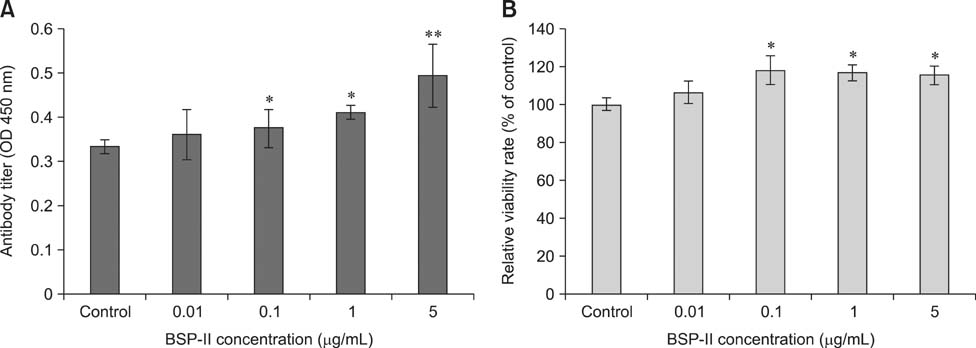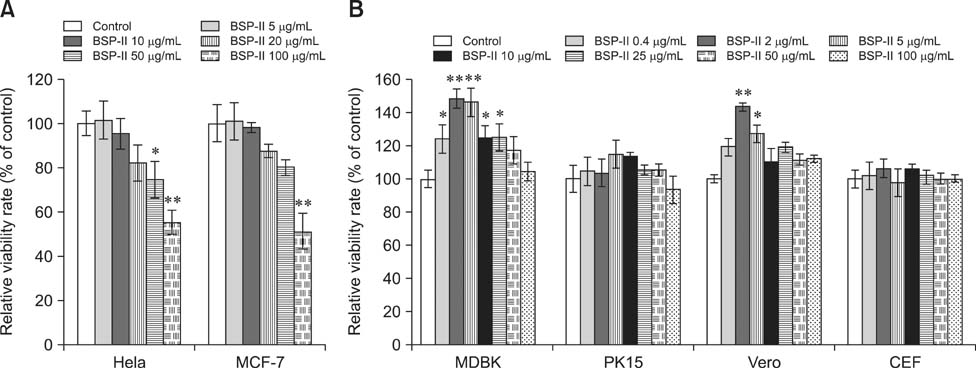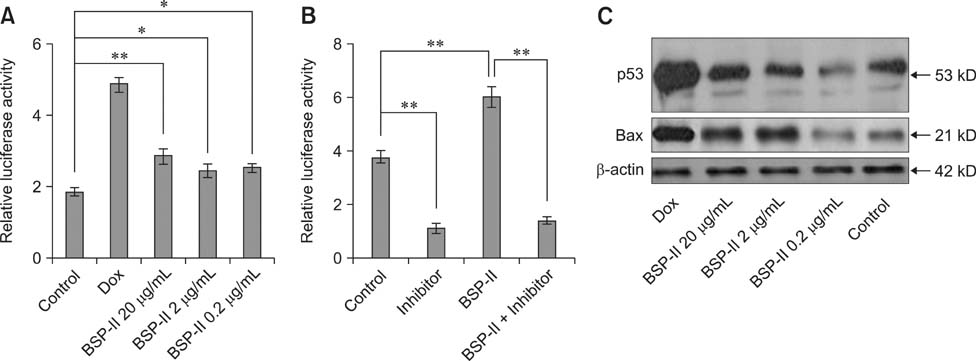J Vet Sci.
2015 Sep;16(3):325-331. 10.4142/jvs.2015.16.3.325.
The potential molecular effects of bursal septpeptide II on immune induction and antitumor activity
- Affiliations
-
- 1Division of Key Lab of Animal Disease Diagnosis and Immunology of China's Department of Agriculture, College of Veterinary Medicine, Nanjing Agriculture University, Nanjing 210095, China. xiulifeng@njau.edu.cn, crb@njau.edu.cn
- 2Institute of Veterinary Medicine, Jiangsu Academy of Agricultural Sciences, Nanjing 210014, China.
- 3Shanghai Veterinary Research Institute, Chinese Academy of Agricultural Science, Shanghai 200241, China.
- KMID: 2344305
- DOI: http://doi.org/10.4142/jvs.2015.16.3.325
Abstract
- The bursa of Fabricius (BF) is the acknowledged central humoral immune organ in birds. Bursal septpeptide II (BSP-II) is an immunomodulatory bioactive peptide isolated from BF. To understand the effects of BSP-II on immune induction, gene expression profiles of hybridoma cells treated with BSP-II were evaluated. Pathway analysis showed that regulated genes were involved in cytokine-cytokine receptor interactions, T cell receptor signaling pathway, and pathway in cancer. It was observed that BSP-II reduced tumor cells proliferation and stimulated p53 expression. These results indicate potential mechanisms underlying the effects of the humoral immune system on immune induction, including antitumor activities. Our study has provided a novel insight into immunotherapeutic strategies for treating human tumors.
MeSH Terms
-
Animals
Antineoplastic Agents/*pharmacology
Avian Proteins/*pharmacology
Bursa of Fabricius/immunology
Cell Proliferation/drug effects
Chickens/*immunology
Hybridomas/drug effects
Immunologic Factors/*pharmacology
Oligonucleotide Array Sequence Analysis/veterinary
Signal Transduction/*drug effects
*Transcriptome
Antineoplastic Agents
Avian Proteins
Immunologic Factors
Figure
Reference
-
1. Audhya T, Kroon D, Heavner G, Viamontes G, Goldstein G. Tripeptide Structure of bursin, a selective B-cell-differentiating hormone of the bursa of fabricius. Science. 1986; 231:997–999.
Article2. Bialik S, Kimchi A. The death-associated protein kinases: structure, function, and beyond. Annu Rev Biochem. 2006; 75:189–200.
Article3. Blink SE, Fu YX. IgE regulates T helper cell differentiation through FcαγRIII mediated dendritic cell cytokine modulation. Cell Immunol. 2010; 264:54–60.
Article4. Boehme KA, Blattner C. Regulation of p53: insights into a complex process. Crit Rev Biochem Mol Biol. 2009; 44:367–392.5. Brand A, Gilmour DG, Goldstein G. Lymphocyte-differentiating hormone of bursa of Fabricius. Science. 1976; 193:319–321.
Article6. Davison F, Kaspers B, Schat KA, editors. Avian Immunology. 1st ed. New York: Academic Press;2008.7. Feng X, Liu T, Wang F, Cao R, Zhou B, Zhang Y, Mao X, Chen P, Zhang H. Isolation, antiproliferation on tumor cell and immunomodulatory activity of BSP-I, a novel bursal peptide from chicken humoral immune system. Peptides. 2011; 32:1103–1109.
Article8. Feng X, Su X, Wang F, Wei J, Wang F, Cao R, Zhou B, Mao X, Zheng Q, Chen P. Isolation and potential immunological characterization of TPSGLVY, a novel bursal septpeptide isolated from the bursa of Fabricius. Peptides. 2010; 31:1562–1568.
Article9. Feng XL, Liu QT, Cao RB, Zhou B, Wang FQ, Deng WL, Qiu YF, Zhang Y, Ishag H, Ma ZY, Zheng QS, Chen PY. A bursal pentapeptide (BPP-I), a novel bursal-derived peptide, exhibits antiproliferation of tumor cell and immunomodulator activity. Amino Acids. 2012; 42:2215–2222.
Article10. He L, He X, Lim LP, de Stanchina E, Xuan Z, Liang Y, Xue W, Zender L, Magnus J, Ridzon D, Jackson AL, Linsley PS, Chen C, Lowe SW, Cleary MA, Hannon GJ. A microRNA component of the p53 tumour suppressor network. Nature. 2007; 447:1130–1134.
Article11. Miyashita T, Reed JC. Tumor suppressor p53 is a direct transcriptional activator of the human bax gene. Cell. 1995; 80:293–299.
Article12. Oltvai ZN, Milliman CL, Korsmeyer SJ. Bcl-2 heterodimerizes in vivo with a conserved homolog, Bax, that accelerates programmed cell death. Cell. 1993; 74:609–619.
Article13. Pike KA, Baig E, Ratcliffe MJH. The avian B-cell receptor complex: distinct roles of Igα and IgXMLLink_XYZ in B-cell development. Immunol Rev. 2004; 197:10–25.
Article14. Qiu Y, Shen Y, Li X, Liu Q, Ma Z. Polyclonal antibody to porcine p53 protein: a new tool for studying the p53 pathway in a porcine model. Biochem Biophys Res Commun. 2008; 377:151–155.
Article15. Ranger AM, Malynn BA, Korsmeyer SJ. Mouse models of cell death. Nat Genet. 2001; 28:113–118.
Article16. Ratcliffe MJH. Antibodies, immunoglobulin genes and the bursa of Fabricius in chicken B cell development. Dev Comp Immunol. 2006; 30:101–118.
Article17. Rossé T, Olivier R, Monney L, Rager M, Conus S, Fellay I, Jansen B, Borner C. Bcl-2 prolongs cell survival after Bax-induced release of cytochrome c. Nature. 1998; 391:496–499.
Article18. Sayegh CE, Ratcliffe MJH. Perinatal deletion of B cells expressing surface Ig molecules that lack V(D)J-encoded determinants in the bursa of Fabricius is not due to intrafollicular competition. J Immunol. 2000; 164:5041–5048.
Article19. Shen S, Chuck MI, Zhu M, Fuller DM, Yang CW, Zhang W. The importance of LAT in the activation, homeostasis, and regulatory function of T cells. J Biol Chem. 2010; 285:35393–35405.
Article20. Soloski MJ. Recognition of tumor cells by the innate immune system. Curr Opin Immunol. 2001; 13:154–162.
Article21. Szabo SJ, Dighe AS, Gubler U, Murphy KM. Regulation of the interleukin (IL)-12R β2 subunit expression in developing T helper 1 (Th1) and Th2 cells. J Exp Med. 1997; 185:817–824.
Article22. Tan AH, Wong SC, Lam KP. Regulation of mouse inducible costimulator (ICOS) expression by Fyn-NFATc2 and ERK signaling in T cells. J Biol Chem. 2006; 281:28666–28678.
Article23. Wiesel M, Joller N, Ehlert AK, Crouse J, Spörri R, Bachmann MF, Oxenius A. Th cells act via two synergistic pathways to promote antiviral CD8+ T cell responses. J Immunol. 2010; 185:5188–5197.
Article
- Full Text Links
- Actions
-
Cited
- CITED
-
- Close
- Share
- Similar articles
-
- Antimicrobial and Antitumor Photodynamic Effects of Phleichrome from the Phytopathogenic Fungus Cladosporium Phlei
- Isolation and immunomodulatory activity of bursal peptide, a novel bursal peptide from the chicken bursa of Fabricius
- Resveratrol from Peanut Sprout Extract Promotes NK Cell Activation and Antitumor Activity
- Evaluating Antitumor Activity of Kiatomab by Targeting Cancer Stem Cell-Specific KIAA1114 Antigen in Mice
- Immunomodulating and Antitumor Activities of Exo-secretion from Phellinus linteus




